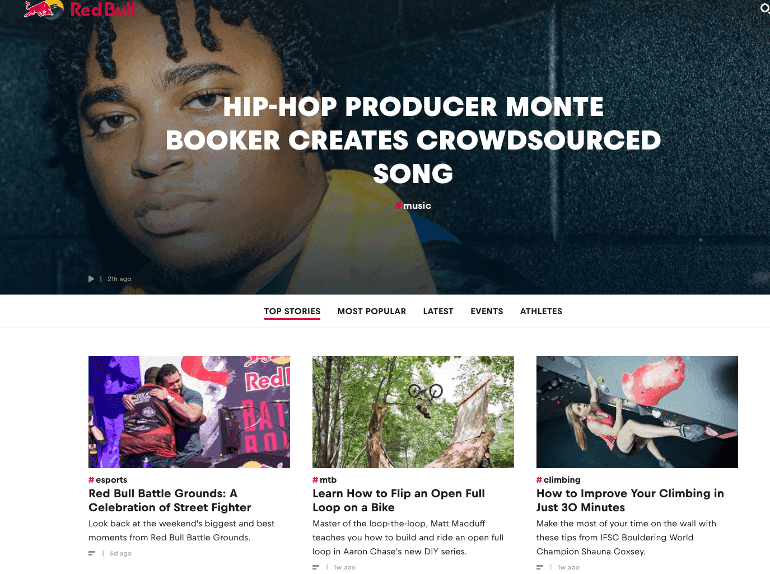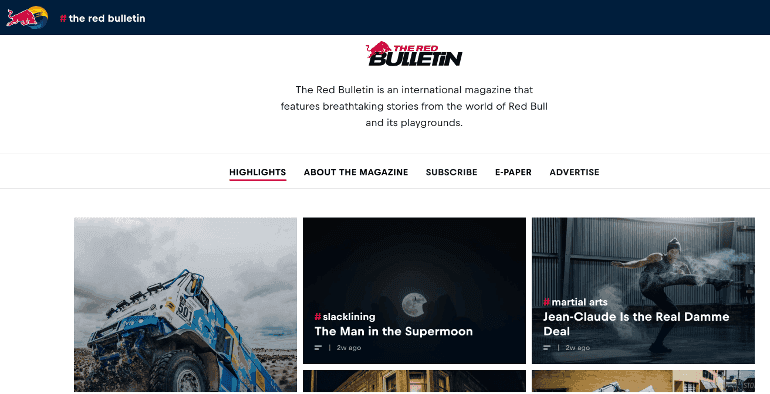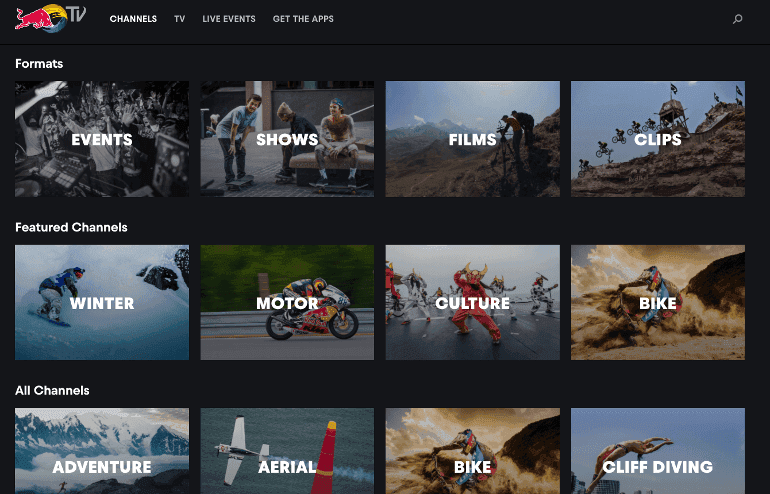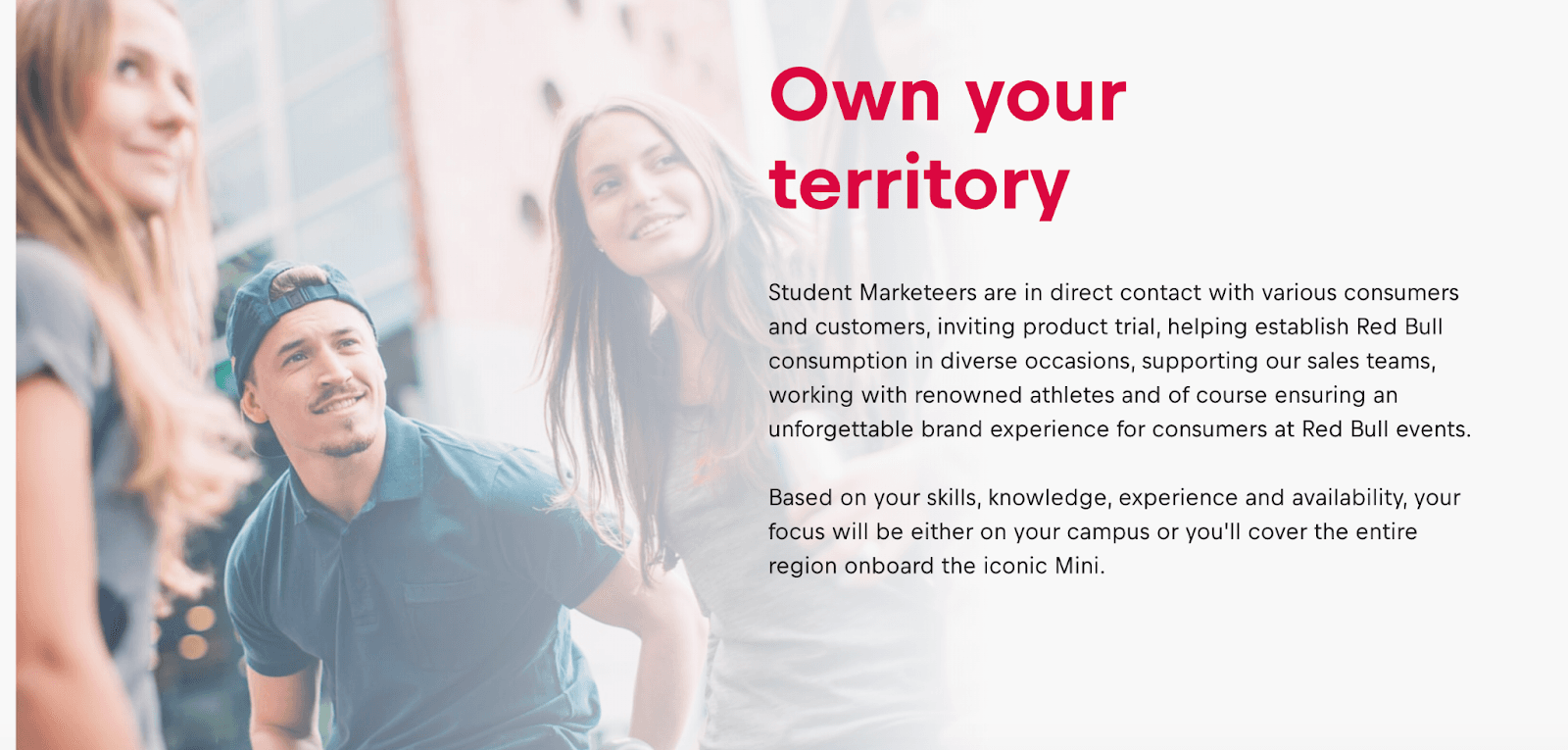Red Bull is an unbeatable marketing powerhouse. When it comes to their marketing strategy, the brand takes everything it does to the extreme. While they use tons of different tactics, everything revolves around one concept: creating content and experiences people would be interested in, even if they don’t care about energy drink brands.
By going above and beyond to produce content on par with major publishers, pull off mind-blowing events, and more, they’ve become one of the most talked about brands in the world.
Red Bull first came to the market in 1987 after Austrian toothpaste salesman Dietrich Mateschitz came to Thailand and heard about an “energy tonic” created by Chaleo Yoovidhya. The tonic was supposed to help keep drinkers awake and alert.
After three years of testing, Red Bull launched in Austria, but the two businessmen had doubters. “There is no demand in the market for this type of drink,” they said. There was no way anyone would go for it.
They were wrong.
Today, Red Bull dominates, with over 43% of the market share in 2015. The best part? They’re still going strong. Considering Red Bull created the market in the first place, dominating just about half of it after nearly three decades isn’t bad.
Check out this infographic of their whole history:

When Red Bull first came out, energy drinks didn’t exist, and traditional advertising was expensive.
So, Red Bull went rogue and went with a different strategy.
What did they do, exactly?
They simply went straight to their target audience (18 -35-year-old males) at college parties, libraries, coffee shops, bars, and other places where they hang out.
Giving their audience free samples helped them put the product right in their consumer’s hands.
That got their audience talking, spreading the word about their product for free.
Today, they still employ a similar strategy: they go wherever their audience is.
Whether that means sponsoring a music festival or creating top-notch cultural content, they’ll do it.
In fact, the content Red Bull publishes is executed at the same level as a professional publishing house. They’re effectively a media company that happens to sell an energy drink rather than the other way around.
Red Bull’s slogan, “Red Bull Gives You Wings,” has guided the brand to the highest market share of an energy drink. This slogan, created to target their target audience, nods to giving you and your thoughts wings with the energy to take off.
They bring their slogan to life by showcasing major stunts in their marketing, like skydiving or wingsuit flying. This tactic has proven to be a massive success for their brand engagement.
Red Bull focuses on three significant tactics to attract its target audience:
- Publishing awesome content: The content that the Red Bull marketing team creates is on the same level as other major media outlets that their audience might consume content from.
- Colossal publicity stunts: Red Bull takes “Go Big or Go Home” to the next level by producing massive stunts that cause everyone to freeze and watch what happens.
- Sponsoring or creating events: Red Bull proved its marketing prowess by taking its product and associating it with things its audience loves by sponsoring or creating events for them.
How Red Bull Approaches Content Marketing Strategy
Red Bull’s content does three things exceptionally well.
First, it covers topics that interest its audience. Extreme sports, concerts, and music festivals are just a few topics covered on the Red Bull website. Picture anywhere you might see someone enjoying (or needing) a Red Bull, and their content will cover it.
Second is their ability to sell their brand but not push their product. Their content focuses solely on the reader’s enjoyment, not selling Red Bull. In turn, their audience begins associating their product with content they love to consume.
Third, it publishes videos, blog posts, landing pages, and other types of content at the same professional level as media sites where its target audience consumes content.
Take this video, for example. It’s a high energy, high impact, and full of content that people who love extreme air stunts would enjoy:
How Red Bull Uses Publicity Stunts To Generate Hype
Another piece of the Red Bull marketing strategy is their insane publicity stunts. They sent a man up 128,000 ft above the earth in a small ship and helium balloon and had him free fall out of it. This stunt, commonly known as the Red Bull Stratos Jump, broke two different world records:
Creating massive stunts, like the Stratos Jump, causes their audience (and, let’s face it, probably everyone else) to stop and think, “Whoa, what’s that? I NEED to watch this.”
How Red Bull Uses Events To Reach Customers
The third part of their strategy involves hosting and sponsoring events their target market is already attending. Whether that means music festivals, film events, or even extreme cliff diving, Red Bull will either create or sponsor an event around them.
Why is this a brilliant move? Their audience is already there. Their target audience is an active group. They’re trying new and crazy stunts; they love extreme sports or rocking out at a music festival.
So Red Bull shows up at places they know their target audience would be.
Take Coachella, for example. This massive music festival takes place over two weekends in the desert, and fans don’t want to miss a second. That may mean sacrificing a few hours of sleep.
Red Bull shows up and gives them the wings (and energy) they need to stay awake and keep jamming at the festival.
Now that you’ve seen some of Red Bull’s marketing strategies in action, let’s look at their overall marketing mix with a breakdown of their 4 Ps (product, price, place, promotion).
Product
Red Bull is unlike many other beverage companies in its simple product mix.
Though the company has launched multiple flavor varieties, non-alcoholic mixers, and a sugar-free version of its original recipe, the primary driver of sales for Red Bull is the original recipe variety.
Red Bull has seen increased success as consumer preference shifted from carbonated soda to energy drinks.
Price
Red Bull holds a dominant market share in the energy drink industry, allowing them to follow a premium pricing strategy for most of its products. However, they still need to account for value-based pricing when setting standard prices for their drinks.
Place
Red Bull is sold in 171 countries worldwide, and the company sold 7.9 billion cans worldwide in 2020.
Ease of availability is huge for Red Bull’s sales numbers, and its availability in supermarkets, convenience stores, nightclubs, and more has contributed to its massive success on the world stage.
Promotion
Red Bull spends millions annually to promote their products and ensure they are at the top of the mind of those looking for energy drinks.
“Red Bull Gives You Wings,” the company’s famous tagline, is used in most of their advertisements, which are often shared digitally or on TV and streaming services.
Aside from traditional advertising, Red Bull’s sponsorships and publicity stunts make them especially appealing to younger audiences. Just think about Felix Baumgartner standing on his jump pad in the stratosphere above Earth before plummeting further and faster than any human before — wearing Red Bull gear from head to toe. That’s quite a way to create brand awareness.
Red Bull’s ability to stay true to its branding and values makes them successful.
1. Maximizing The Idea Behind Their Tagline
Red Bull’s messaging strategy revolves around its tagline, “Red Bull gives you wings.” It focuses on the idea that its product gives people the “wings” or energy they need to do whatever they want when they want.
This tagline fuels their content because they produce and record some of the most action-packed, high-flying sports and activities the world has ever seen.
Need a little help jumping out of a plane in a flying suit? Let Red Bull give you the extra push you need.
2. Keeping Consistent Visual Branding
The visual branding that Red Bull has created is a key contributor to the brand’s success.
Take a look at one of their more recent YouTube videos:
The content keeps the watcher engaged through a fast-paced, high-intensity stunt that leaves them wondering if they’ll be able to pull it off.
That edge-of-your-seat, shock-inducing mentality is what Red Bull’s branding is all about. In turn, they’re able to say, “we gave people the energy (and courage) they needed to attempt something this crazy.”
3. Letting Values Be Their Guide
Their values play a role in their content as well. They center around one core phrase “giving wings to people and ideas.” Everything that the Red Bull team communicates revolves around that tagline and its values.
The ability to keep that communication consistent over the past 30 years has led to their success.
4. Building A Strong Content Core
Red Bull’s content core can be summed up by saying:
“Red Bull’s content core revolves around the intersection between their audience’s interest for extreme sports, festivals, and a fast-paced lifestyle with their product’s ability to keep people awake and give them energy during those events.”
They focus on extreme sports, music, art, dance, nightlife, and much more. Because of that broad spectrum, their content can appeal to the right audience.
There is one thing that Red Bull does with its content core that pushes them ahead of the pack.
Every piece of content they create matches the quality of other publications their target audience might read, like Buzzfeed, Vice, ESPN, and more. That level of quality makes it seem like it’s coming from a powerhouse dedicated to creating consumable media, not an energy drink brand.
5. Creating Content Around What Their Audience Loves
What does every topic they cover (and a lot of them) have in common?
They focus on activities their audience would participate in while consuming their products. They also publish that content everywhere their audience is likely to hang out.
They publish a massive amount of material on their website, which, surprisingly, has no mention of their product whatsoever:

They produce a magazine, The Red Bulletin, which circulates over 2.2 million copies a month:
 They also create fantastic, awe-inspiring videos:
They also create fantastic, awe-inspiring videos:
In summary, if their target audience is consuming content on a given channel, you can count on Red Bull being there.
6. Revamping The Way They Use Traditional Media
It’s not just content marketing that Red Bull dominates. The brand invests a substantial amount in traditional mass media channels as well.
Red Bull’s TV content operates in two formats: videos they create for their online channels (YouTube, social media, etc.) and ads that they partner with traditional TV channel content:
Their TV content resides on their online hub called Red Bull TV. Their videos and shows are segmented into formats like ‘Events’ and ‘Films’ as well as channel topics like ‘Cliff Diving’ and ‘Culture’:

They’ve moved into the music realm too. In addition to covering or sponsoring massive musical festivals, Red Bull also boasts its own record label, recording studio, music academy, publishing group, and online radio station.

7. By Being Loud & Proud With Social Media Strategy
Social media is another channel that Red Bull dominates with authority.
Their Facebook page, for example, is full of artistic videos that blend visually appealing images, music created by their own record label that pumps up viewers, and the sports and events their audience loves.
Their message is short and sweet, while the first 3 seconds leave you wondering what is happening. You have no choice but to see it through to the end:
On the other hand, their Twitter and Instagram channels focus on “wow” worthy images to promote shares and interaction with their fans.
What’s a wow-worthy image for Red Bull? According to Link Humans, it’s images that capture speed, sport, and motion:
Their ability to create dynamic social media posts that are so engaging it stops fans from scrolling past them makes them a social media success. Each media piece looks like its subject is in motion, which reflects the brand’s high-energy aesthetic.
8. Bringing The Product To The Audience With Sponsorships & Events
Finally, Red Bull’s sponsorship and events are the last part of their marketing strategy that seals the domination of their brand. Let’s break their efforts into three categories:
- Publicity stunts.
- Events they’ve created.
- Sponsorships.
Their publicity stunts are so crazy it forces the world to stop and watch. Of course, there’s their Stratos Jump, but there’s more.
Take the Red Bull Air Force team, for example. This group is dedicated to pulling off some of the craziest aerial acrobatics ever seen:
Then there are their events, like Red Bull Crashed Ice or Red Bull Queen of the Bay, which focuses on specific sports like ice cross or surfing. These events focus on fans of the sport and raise awareness of the Red Bull brand.
Finally, there are sponsorships. Red Bull is involved with everything from the Electric Daisy Carnival in Las Vegas to Coachella. It’s a genius move on the company’s part because who attends all of those events? Their target audience.
Also, those sponsorships allow Red Bull to expose the brand to new audiences due to the sheer number of people who attend.
9. Use Student Marketers
Red Bull created a student marketer program, also known as their “Wings Team”, which is different from what any brand is doing. You may see brands using people as brand ambassadors, but Red Bull takes it further and allows students to be involved in their marketing.
This strategy continues to build on their brand image and values and invests in future marketers. Student marketers are getting valuable marketing experience from one of the top marketers in the world, and Red Bull continues to increase brand awareness.

Red Bull’s strategy works because of three different things:
- The first is their ability to tell a story that entices their audience. Their focus on everything from extreme sports to music festivals gives them a broad playing field, but it’s not just that.
- Red Bull puts its product second and the content and value it can give its audience first. The attention to detail that their marketing team gives is evident. These people care about the topics they are writing, recording, or creating content around.
- Finally, their commitment to the values and aesthetics the brand created when they first started makes their marketing work. Everything they create relates to the idea of giving people and ideas wings to fly.

It goes without saying, Red Bull has come a long way in the 30 years since its inception. Red Bull is a marketing success story from humble beginnings to the mega-brand publishing house it is today.
Seem intimidating?
Let their story remind you that your organization needs to start somewhere. They didn’t go from an idea in Thailand to a multi-mega corporation overnight. That took time, luck, and some seriously hard work (and a lot of great marketing along the way).
Follow their lead by starting small. Here are some ideas:
- Create a short weekly video series on a topic that interests your audience.
- Curate social media content that intersects with your product’s purpose and your audience’s interests (without directly referencing yourself).
- Publish an email newsletter full of cool and useful stuff your audience might like (and maybe slap your logo in there somewhere).
The main takeaway is this: to succeed at content marketing like Red Bull; you have to put your audience’s interests first and create stuff that looks and sounds like the kind of content they consume from publishers.
Instead of emulating other marketers, that means emulating magazines, TV shows, news websites, and anything your audience might read and watch.
Where will your wings take you from here?

